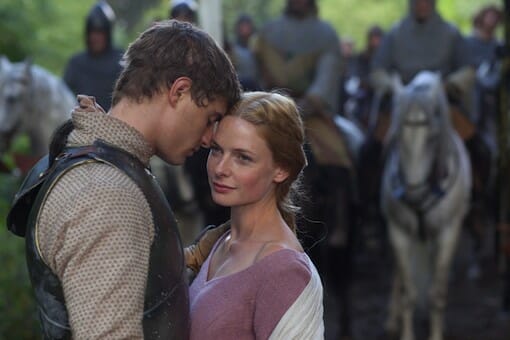By Renita Wilheims · August 13, 2013

The article says it all. No, not a newspaper article, but the article “the.” The season premiere of The White Queen came on Saturday August 10, 2013. Notice how it is not “a” white queen. By using “the” it leans towards a specific or particular “white queen.” A white queen could be one of several, but by using “the,” only one person can be considered THE white queen. This sets up one of the problems in the episode—who is going to be queen? But not just any queen—white. White is synonymous with purity, cleanliness, and innocence. However, white can also be considered weak—the color gets dirty easily. White in this case also represents the House of York. When the Lancaster family wanted to show their loyalty to the new king, they donned white roses. So the “white queen” will now be a part of the House of Lancaster.
Let’s rewind for a second and go back to the white rose: in the beginning of the series we read, “The War of the Roses has been raging for nine long years. Two royal houses, Lancaster and York, fight for the throne of England.” We already know that the white roses belong to the House of York and we find out later that the color red represents the House of Lancaster. Red also stands for passion, anger, and blood. Both house symbols are roses. Upon first look a rose appears fragile. The petals fall off easily and they take a lot of care to grow. But what about the infamous thorns? If anyone has ever picked up a rose and been pricked they know to be more cautious next time.
The war of the roses…(ding ding…)
In one corner, we have Elizabeth Woodville (Rebecca Ferguson); in the other we have King Edward IV (Max Irons). Elizabeth comes from the Lancaster house and the new king is of the York house. The fact that he is a new king is important; he defeated the king to whom the Lancasters were loyal, King Henry VI (who was only mentioned in this episode). The series starts with Elizabeth waking up from a dream about her husband dying (he had fought for the losing side of King Henry VI). Now she is a widow and wants to petition King Edward IV for her son’s inheritance. As she goes to petition, she takes her two sons and her mother gives her an amulet for luck. Elizabeth responds “nothing will help me with a man like him.” At this moment it is assumed that she is talking about King Edward IV, but she could be talking about the king’s cousin Lord Warwick (James Frain) because as soon as she sees the king she goes from afraid to flirtatious. The sexual tension between the king and Elizabeth, although nonverbal, is tangible. She darts her eyes from his glance and uses her son Thomas Grey (Otto Farrant) as a shield by rubbing his hand.
Elizabeth meets the king on the road by the trees. Here, nature might represent witchcraft and the road might refer to paths taken or not. During the night, Elizabeth’s mother Jacquetta Woodville (Janet McTeer) disturbs her sleep by taking her outside showing her three strings tied to the tree, with each string representing a path. Elizabeth’s path leads her into the arms of the king.
Later, the king tells Elizabeth that he is off to war and that she should bid him farewell. However, the king has less than honorable intentions towards her. While they are seated on a blanket in the woods, he tries to sleep with her. When she refuses, he tries to force himself on her. She takes his knife and places it on her neck. Elizabeth’s features become the physical juxtaposition between the two families. Her face is white but she has reddish freckles, her hair is reddish-blonde and her neck is white, but she cuts herself and the red blood is so distinct against her skin. Where do her loyalties truly lie—with the Lancasters or with the Yorks?
What about the king? Even though his house symbol is white, he gives into his passions and is easily incensed. So far he has been the puppet to his cousin. However, when the king falls in love with Elizabeth and names her queen, maybe he is beginning to think for himself. Were do the king’s loyalties lie: with his Lancaster Queen, or with his cousin?
The show ends with Elizabeth seeing a vision of a woman with blood on her hands. The woman is wearing red and Elizabeth thinks that the blood is her own. The woman wearing red must be from the Lancaster House. Moving forward, I anticipate seeing how Elizabeth handles being queen and her enemies. However, one thing that should be improved upon is using witchcraft as a means to foreshadow events. What lies in store for The White Queen, and will there be a new one? Only time will tell.